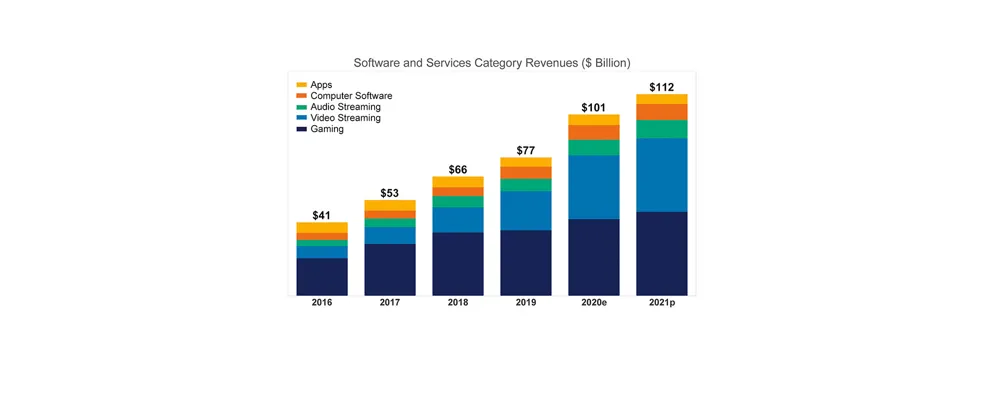The CTA 2021 Forecast
January 11, 2021
- Author: Rick Kowalski, CTA Sr. Director, Business Intelligence
Consumer technology keeps people connected and entertained during tough times while vaccines bring promise of life returning to normal after a long year of uncertainty.
As the new year begins, vaccines bring promise of life returning to normal after a long year of uncertainty. For the consumer technology industry, the COVID-19 pandemic was a mixed bag. Consumers cut back on smartphone purchases, automotive technology and smartwatches, but demand for computing products, smart home devices and entertainment services helped lift industry revenues 5.5% to $442 billion last year. In the coming year, the industry will be shaped by a slow emergence from lockdown life into economic recovery, growing 4.3% to $461 billion.
The Consumer Technology Association (CTA)® U.S. Consumer Technology One-Year Industry Forecast uncovers key growth areas, revenue drivers, emerging technologies and more for the upcoming year. Here is a closer look at major consumer technology trends that helped the industry find growth in 2020 and how those trends will shape the year ahead.
2021: A Tale of Two Halves
What drove growth in 2020 will bring more of the same this year, as consumers continue to observe social distancing measures and refrain from activities like travel, live entertainment and dining out. With consumers spending less elsewhere, technology is a good investment at the moment. Teleworkers and those with children in the home are spending more on computing and home office equipment, while others are enhancing their surroundings with smart home technologies.
As the year proceeds, businesses reopening and those returning to work will drive technology purchases of devices that were delayed during the pandemic. Regardless of how the recovery progresses, the industry will see demand from both the lockdown lifestyle and the post-pandemic lifestyle.
Computing and Connectivity
A strong, robust and ubiquitous internet infrastructure allowed students to remain connected with their teachers, workers to stay in touch with their employers, and friends and families to reach out to one another. Computing products are serving as our window to connectivity, making them the most highly sought-after devices through the pandemic.
Laptop revenues leapt 19% in 2020, as working and learning from home became necessary for millions of Americans. Laptop shipments will plateau at an impressive 68.6 million in 2021, benefitting from both consumer demand in the first half and enterprise demand picking up in the latter half, while revenues dip 2% in 2021 to $38.4 billion.
Tablets were able to help fill computing needs when laptops were hard to find, and they served as an entertainment tool for children and adults alike in 2020. Tablet revenues rose 5% in 2020 to $9.6 billion and will see a slight decline of 1% this year.
Meanwhile, reductions in traveling and commuting equated to less demand for smartphones. Although they are still by far the most popular tech product, smartphone shipments to the U.S. declined 5% in 2020 to 154 million units. As the economy recovers, smartphone shipments will bounce back up to 161 million units in 2021. Most notably, 5G phones will make up an impressive 43% of all smartphones in the coming year, bringing in the next generation of cellular tech.
Digital Health
The pandemic brought attention to new digital health technologies like connected health monitoring devices, which grew revenues 73% to $632 million in 2020. Pulse oximeters and thermometers were especially helpful for those tracking the symptoms of COVID-19, but blood pressure monitors and blood glucose monitors will likely drive growth in the future as more people use them to track chronic conditions like hypertension and diabetes.
The health care industry embraced and popularized telehealth services in 2020, helping people check in with their doctors while social distancing. Digital therapeutic apps also thrived, helping people track their fitness, diets and mental well-being. And the industry awaits finalized FDA regulations this year regarding over-the-counter hearing aids, which will open a market for a new class of devices that will offer low-cost solutions for those with hearing loss.
Entertainment
The cloud-based, on-demand economy jumped into full gear in 2020, as demand for video and audio subscription services and gaming surged. Consumer spending on software and services rose a phenomenal 31% in 2020 and will see another impressive year of growth in 2021, with spending expected to reach $112 billion.
Video streaming helped many people pass the time in 2020. Video streaming spending rose an astounding 63% to $35 billion last year. Gaming was even more popular, with consumers spending $43 billion, which will grow another 8% to $47 billion in 2021. Audio streaming services are broadening their appeal with podcasts and audiobooks, helping to grow spending to over $10 billion this year.

Intelligence of Things
The industry continues to enhance the intelligence of things, building devices that can dynamically adjust to their surroundings, be it a vehicle with automated safety features, a refrigerator that can order food to keep itself stocked, or wireless earbuds that change their volume based on external noise levels. Beyond this, connectivity is allowing devices to tap online knowledge bases and artificial intelligence platforms to help their built-in digital assistants better communicate with their users.
Regardless of how 2021 plays out, consumer technology will rely on its versatility and resilience to have another successful year.
Learn more about these trends and more in the full CTA U.S. Consumer Technology One-Year Industry Forecast.
Join our community of innovators and shape the future of technology.



